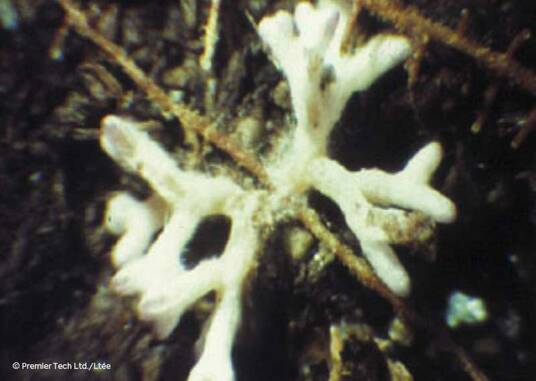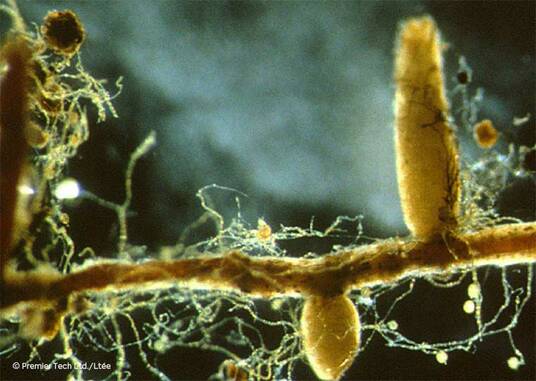
Mycorrhizal fungi have been vital to plant health for over 450 million years. They form a symbiotic relationship with plant roots, offering benefits such as improved growth, greater resistance to stress, and enhanced soil quality. In landscaping—especially for trees, shrubs, and various plants—mycorrhizae are crucial for achieving the best results.
The Early Symbiosis: Mycorrhizae and Plant Survival
As plants began to inhabit dry land, they faced a tough environment with limited access to water and nutrients. To survive, plants formed partnerships with mycorrhizal fungi, allowing them to access essential resources that would otherwise be out of reach. This ancient collaboration was essential for plant adaptation and has established the foundation for the plant diversity we see today.
Understanding Mycorrhizae: Nature’s Root System Extension
Benefits of Mycorrhizae
Mycorrhizae offer a wide range of benefits to plants, making them essential for healthy landscaping. Here are some key advantages:
• Enhanced nutrient absorption: Improves the uptake of water, phosphorus, and other vital minerals.
• Stronger root systems: Encourages better root development, increasing plant stability.
• Greater drought resilience: Helps plants endure in conditions with limited water.
• Enhanced soil structure: The production of glomalin helps bind soil particles, improving aeration and water retention.
• Decreased transplant shock: Aids new plants in establishing more quickly and with less stress.
• Improved nutrient cycling: Contributes to overall soil health, fostering long-term plant growth.
How Mycorrhizae Colonize Roots
Understanding how mycorrhizae establish their symbiotic relationship with plant roots reveals the benefits they offer. We will explore the colonization process, beginning with spore germination and progressing to the development of the hyphal network, which greatly enhances the plant’s ability to absorb nutrients and water from the soil.
Spore Germination
The initiation of this mutually beneficial relationship between mycorrhizal fungi and plant roots begins with spore germination.
Root Penetration
Thread-like structures known as hyphae penetrate the roots, creating an internal network of vesicles and arbuscules that facilitate nutrient exchange.
Hyphal Network Expansion
Fueled by the carbon produced through enhanced photosynthesis, the hyphae expand their network in the soil, increasing the area from which the plant can draw nutrients and water by as much as 100 times.
Increased Nutrient and Water Absorption
This extensive network acts as a secondary root system, enabling the plant to access nutrients and water that were previously out of reach in the soil.
Types of Mycorrhizae Mycorrhizae are classified into two categories, each playing a distinct role in promoting plant growth. Ectomycorrhizae form between root cells, while endomycorrhizae penetrate root cells. Both types create a network that enhances nutrient and water exchange, strengthening plant resilience and improving overall soil health.


Advantages of Combining Endo and Ecto Mycorrhizae
• Broader Application: The combination of both types ensures that a wide variety of plants, including trees, receive optimal support.
• Flexibility: Professional landscapers can be confident that there are no restrictions based on plant type. The different fungi will colonize appropriate plants without causing harm.
• Maximized Plant Health: This combination results in stronger root systems, enhanced nutrient uptake, and increased resistance to stress.
Mycorrhizae and Soil Structure: The Importance of Glomalin
Mycorrhizae not only promote plant vitality but also enhance soil quality. The mycelium produces glomalin, a glycoprotein that helps bind soil particles together.
This process leads to the creation of soil aggregates, which improves soil structure by:
• Increasing water retention
• Enhancing air permeability
• Reducing soil erosion
• A well-structured soil supports root growth, microbial activity, and nutrient cycling, all of which contribute to healthier plants and more resilient ecosystems.
Mycorrhizae for Landscapers: Enhancing Efficiency and Outcomes
Mycorrhizae offer landscapers considerable benefits, including faster plant establishment, minimized transplant shock, and improved soil health, resulting in fewer job site returns and lower plant losses. With improved root systems and better nutrient absorption, mycorrhizae provide a cost-effective and sustainable approach to landscaping.
